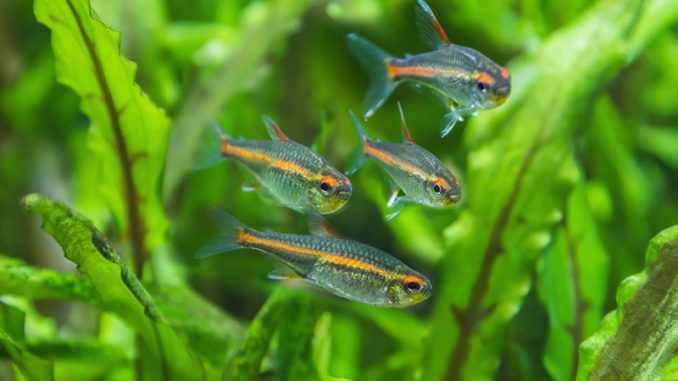
The glowlight tetra is a beautiful freshwater fish. The glowlight tetra is native to the Guyana river in South America and is active, colorful, easy to care for, and fun to watch.
Like all tetras, glowlight tetras can survive in different aquarium environments. These fish belong to the Characidae family and are popular among aquarists because of their hardiness, friendly behavior, and peaceful nature. Glowlight tetras are the perfect species for beginner aquarists and can help hobbyists gain experience in keeping fish.
TABLE OF CONTENTS
Glowlight Tetra Facts & Overview
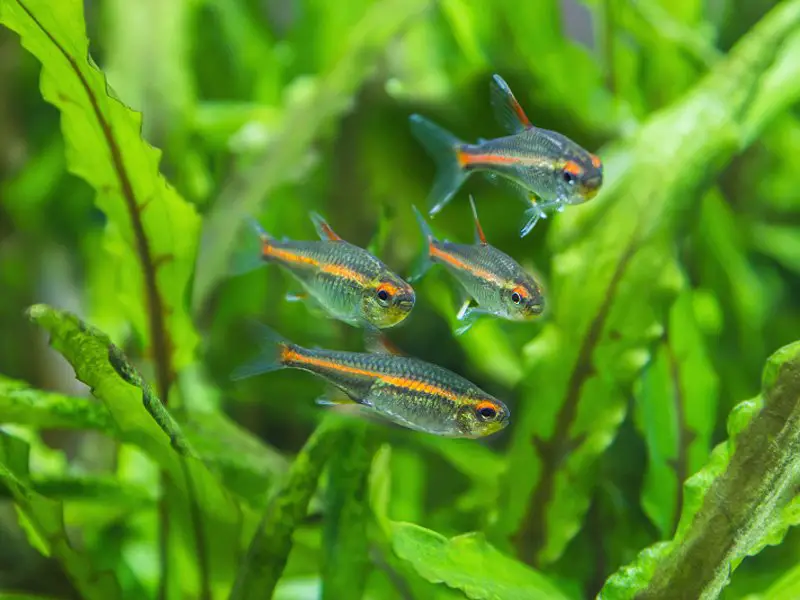
| Category | Rating |
| Care Level: | Easy |
| Temperament: | Peaceful |
| Color: | Translucent with a silvery-peach colored body |
| Lifespan: | Four years |
| Size: | 1.5 inches |
| Diet: | Omnivorous |
| Family: | Characidae |
| Minimum Tank Size: | 10 gallons |
| Tank Setup: | Freshwater |
| Compatibility: | Peaceful |
Glowlight tetras are scientifically called Hemigrammus erythrozonus, and they are popular because of their unique coloration and lively personalities.
These fish have translucent, silver/peach-colored bodies divided by a red-orange colored stripe that glows in blackwater, hence the origin of their name, glowlight tetra. Glowlight tetras are often confused with glowlight rasboras and red lines. These fish are of different species, even though they all have similarly-shaped bodies.
Glowlight tetras are found in the Essequibo basin in Guyana, Potaro, and Mazaruni Rivers.
These fish are freshwater fish that have specific water parameter needs. Aquarists must ensure the tank conditions are similar to the fish’s natural habitat. Glowlight tetras thrive in soft and acidic conditions because of the tannins from decaying leaves found in their natural habitats.
Jungle thickets hide glowlight tetras in their natural habitat, making the fish almost impossible to find and catch in the wild. Most aquarists rear and sell them on the market because of how hard they are to find in their natural habitat.
Fortunately, they’re readily available in most local markets and pet stores, and you can get a pair of glowlight tetras for $2.
Glowlight tetras have a lifespan of two to four years. Glowlights can react negatively to substandard water conditions, poor diets, and dirty tanks. You should provide the fish with top-notch care by maintaining water parameters, performing weekly water changes, and providing the glowlight tetras with nutritious diets.
Appearance & Behavior
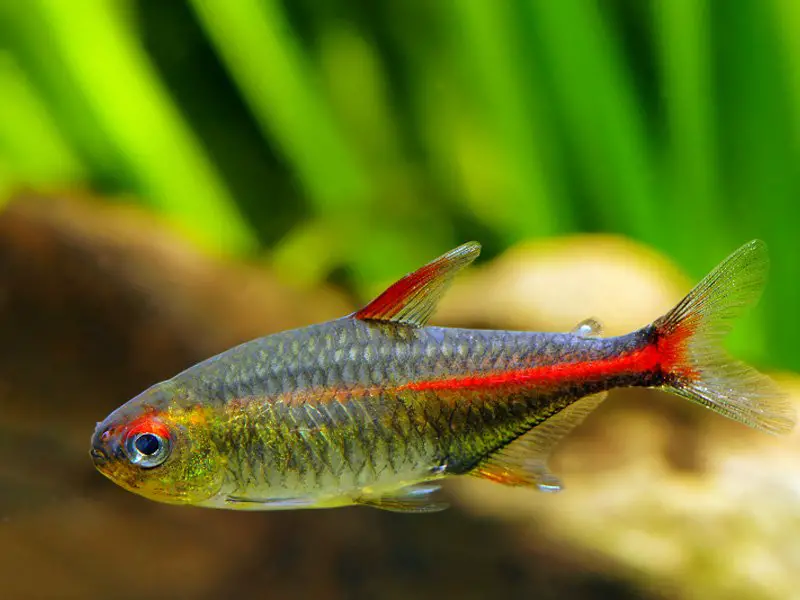
The glowlight tetra is slender and streamlined with distinct colors and markings. The average tetra will measure 1.5 inches when fully grown. This species has a transparent body with a glowing golden stripe from the snout to the tail and they also have silver eyes that match the rest of their bodies. However, it has bold colors in its upper iris, and this differentiates the fish from other species.
Tetras are quiet and peaceful schooling fish. They prefer to live in groups of their own species. For this reason, you should have at least five or more glowlight tetras in a tank.
Glowlight tetras will spend more time hiding if their shoaling groups are small. When the fish are in large groups, they are more confident and adorn the tank with their beautiful color. Still, you must include hiding places in your tank for security.
The differences between male and female tetras are subtle. Female tetras are larger and longer than males, they’re also plumper, and their ventral section is smooth and round. Pregnant female glowlight tetras gain weight in the tail and abdomen area. Males tend to be slender, and their colors are brighter than females. Male tetras chase spawning females around the tank when they breed.
Typical Behavior
Glowlight tetras are active fish that swim in schools and dart around the tank. Tetras that are kept in small groups will spend most of their time at the bottom and hide on the sides of the tank.
Glowlight tetras are timid but peaceful. They quickly adapt to their environment and eat most foods. They can be territorial, and they will get aggressive when kept in insufficient groups. You should always keep a minimum of five fish if you want the fish to feel at home and look cheerful.
They thrive when kept with other fish species. However, slow-moving or long-finned species are unsuitable tank mates for glowlight tetras because the fish will fight.
Glowlight tetras are good tank mates for other tetra species. Add the glowlight tetras to an already established tank, and place them in a tank of at least 10 gallons so that the glowlights will feel comfortable.
Glowlight tetras are beautiful and friendly. Glowlights usually live together in small groups or shoals in the wild. The fish swim together, eat together, and hide together.
Watch out for aggressive behavior, because glowlights can become aggressive toward other fish species as well as towards other glowlight tetras.
Glowlight tetras sleep and rest at night, and they become active in the day. It is easy to tell when tetras are lively because they swim around the tank.
Glowlight Tetra Care
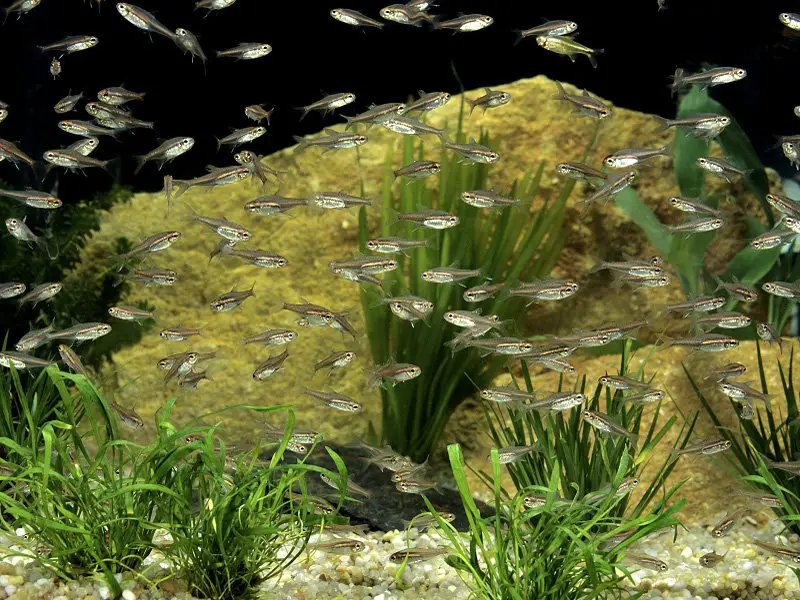
Glowlight tetras are easy to keep and require little attention. Poor water conditions and unsuitable diets will affect the tetras in different ways. Dirty tanks can cause stress and significantly reduce the fish’s lifespan.
Choosing the right tank size, mimicking their natural habitat, and feeding the fish with enough food is vital for their health. Feed them food made up of standard micropellets and live foods.
Watch out for common health issues that can impact your tetras, including bacterial infections, parasitic infections, fin rot, and fungal diseases.
Habitat and Tank Requirements
Tetras are small fish that can live in a small tank. A standard 10-gallon tank can hold half a dozen fish. A larger tank will provide enough space to roam.
Tank Conditions
Ensure the glowlight tetras live in tank conditions similar to the species natural habitat. Tetras are hardy and can tolerate different conditions, so stick to the following parameters:
- Water temperature ranging between 74° and 82°F
- Water hardness of about 6 to 15dGH
- pH levels of approximately 6.5
Simple and natural décor is ideal for a glowlight tetra tank. Mimic the species’ natural environment by adding fine sand or substrate at the bottom of the tank, blackwater, small rocks, pieces of driftwood, and a wide variety of lush vegetation.
Remember to leave enough swimming space in the center of the tank and install a water filter for the best tank environment.
Tank Mates
Glowlight tetras are docile and will coexist with other fish species. You should avoid placing the tetras in the same tank with large or aggressive fish. Tetras are small and can quickly become prey for large predator fish.
Angelfish target glowlight tetras when these species share a tank. Angelfish are known to eat glowlight tetras, so keeping glowlights and angelfish together is dangerous.
Create a peaceful environment and consider peaceful species that are small in size in a glowlight tetra tank. Here is a list of tankmates to consider:
Diet and Feeding
Glowlight tetras are easy to feed. They are omnivorous and will eat plants and animals. Ensure they are fed with floating live and frozen food to improve immunity and color.
Glowlight tetras eat fruit flies, insect larvae, algae, and water fleas in the wild. Feed glowlight tetras with live food once in a while to ensure the fish get the natural nutrients needed to thrive. Watch out for overfeeding glowlights as overeating can cause parasitic diseases.
Feed your tetras several times a day so that each fish receives enough food. Professionals advise giving tetras food that can fit into their mouths. Aquarists tend to struggle to ensure that all the tetras get enough food, especially when the tank contains different schools of tetra.
Diseases
Glowlight tetras are hardy, but they are not immune to diseases. Some of the common aquarium fish diseases you will encounter include:
Ich
Ich is a parasite that attaches to the fish’s body and sucks out its bodily fluids. This parasite manifests itself in white spots on the fish’s body, visible under a microscope and with the bare eye. These white dots will turn into pits that look like sandpaper when magnified. These pits will then develop into white patches on the skin, where the spots will continue to spread.
A glowlight tetra showing signs of ich will need to move to a hospital tank for treatment. Ich is a fast-spreading parasite that will spread to other fish in the aquarium
Fungal Infections
Fungal infections are prevalent when fish swim in stagnant water. Stressed fish become more susceptible to fungal infections, which can be dangerous. An infected fish will require urgent antibiotic treatment.
Fin Rot
Fin rot describes a disease that affects the fish’s fins. The fins turn a reddish-brown color, and the affected area will become covered by black or brown spores. Fin rot is highly infectious. Bacteria from terrible water conditions or previous bacterial infections that remained in the water will cause fin rot.
Treat fin rot by applying medication to the water and keeping the aquarium water clean.
Maintaining a clean and healthy tank environment is the best preventative method. Feed the fish a balanced diet and change the water regularly to remove excess chemicals and waste from the water.
Breeding
Glowlight tetras require ample space to breed. Spawning burns a lot of the female’s energy.
Glowlight tetras need a quiet place without distractions to breed. The fry require lots of light after hatching. This well-lit area should be approximately six to eight inches above the water level.
These are the steps necessary for successful glowlight tetra breeding:
- Select a spawning area for the fish. This area should be dark and spacious and at least six inches away from the main tank to prevent other fish from disturbing the eggs and young fry. Ideally, it should be at least 18 inches long and six inches high.
- Keep two tubes in the tank.
- Feed the fish a high-protein diet to increase egg production and quality. Include spinach or brine shrimp in the pair’s diet.
- Move the parents into their spawning area and remove any other fish from the tank. You should also remove plants or decorations that can hurt the eggs during spawning. The females will lay eggs on leaves and on hard surfaces in the tank.
- The male will follow the female around as she prepares to spawn. The male will begin to swim around the female in the spawning area.
- The females will release several eggs at a time. The males will proceed to fertilize the eggs as the females release them.
Glowlight tetras displaying a loss of appetite are not interested in spawning. The glowlight tetras will also show other signs that the breeding process is failing, such as swimming with their fins clamped and sunken eyes. Their fins will also appear discolored, dull, and pale in color.
Should You Get a Glowlight Tetra for Your Aquarium?
Glowlights are among the most common tetra fish types to keep in aquariums. They are hardy and require little maintenance. On top of that, they are good-looking fish with a cool neon glow.
They are social schooling fish that need to live in groups of five or more schools. Glowlight tetras are also easy to breed, making them excellent choices for a beginner.
If you have a suitable tank and are interested in this beautiful species, the glowlight tetra is definitely right for your aquarium.

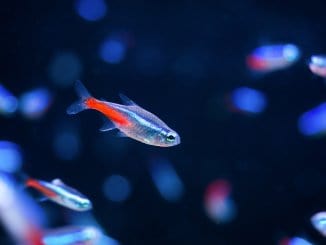
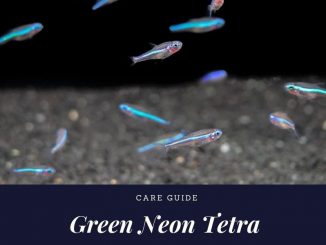
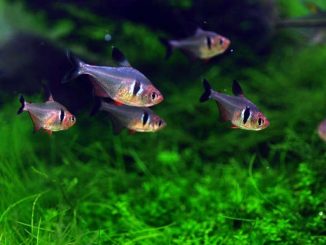
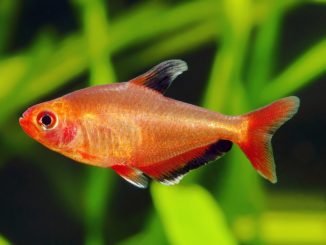

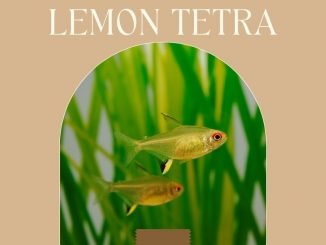
Be the first to comment